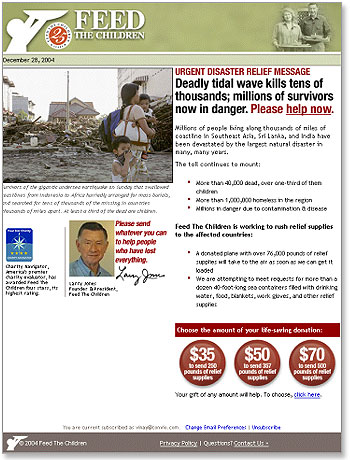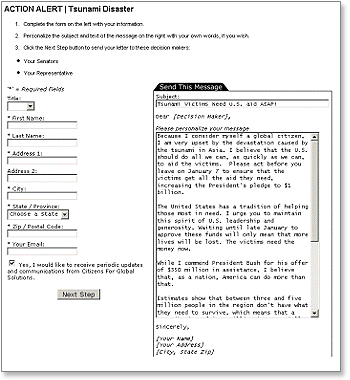|

January/February 2005
The Tsunami Relief Effort: Putting Online Marketing Best Practices into Action
by Vinay Bhagat, Founder and Chief Strategy Officer, Convio
 The modern world has never witnessed a natural disaster of the magnitude of the tsunami that hit Asia in late December 2004. Each day since the tidal wave struck has brought increases in death tolls and more stories of devastated towns and lives. The groundswell of response from governments, corporations and individuals — with more than $5 billion committed to date — is likely to set a record for relief fundraising. And although people around the world have demonstrated tremendous generosity, pressures mount daily for more funding. The modern world has never witnessed a natural disaster of the magnitude of the tsunami that hit Asia in late December 2004. Each day since the tidal wave struck has brought increases in death tolls and more stories of devastated towns and lives. The groundswell of response from governments, corporations and individuals — with more than $5 billion committed to date — is likely to set a record for relief fundraising. And although people around the world have demonstrated tremendous generosity, pressures mount daily for more funding.
Beyond being an efficient fundraising vehicle, the Internet is playing a huge role in raising awareness, motivating consumer response and encouraging governments to give more. An unprecedented flow of information and opinions online is helping to stimulate additional government grants and individual giving.
The role of the Internet on tsunami relief fundraising has been particularly significant in the United States. Many relief agencies are receiving substantially more dollars online relative to other channels. I was in the United Kingdom when the tsunami struck. Almost immediately, an umbrella organization called the Disasters Emergency Committee was mobilized to unify all fundraising efforts. By contrast, fundraising efforts in the states have been much more fragmented. Consequently, brand awareness has played a large role in influencing the flow of funds to well known groups such as the Red Cross. Online marketing efforts by relief agencies, particularly lesser known ones, also have significantly impacted their fundraising effectiveness.
Optimizing “pull” to attract new supporters
Inclusion on tsunami-related lists and Web sites is helping many groups to maximize outreach and attract new supporters. Online resources ranging from the popular search engine Google to e-newsletters published by sites such as Dailycandy.com also are spreading the word about agencies involved in tsunami relief. In addition, many organizations are using search engine optimization and paid search placement for enhanced pull. For example, running a Google search on ”tsunami relief” brings up the American Red Cross among the most popular search links, and Feed The Children as the highest placed sponsored link.
Optimizing “push” through email
Another practice deployed by relief agencies has been to launch email appeals. In recent years, many agencies have developed sizeable, responsive email lists of supporters they can mobilize quickly as crises strike and needs arise.
Feed The Children, Action Against Hunger and Mercy Corps were among the many organizations that sent emails to constituents within days of the tsunami and were able to elicit a strong response. Even smaller groups like Action Against Hunger (which has an annual operating budget of approximately $10 million) are generating big results. In the week following the disaster, this group raised $305,000 online for tsunami relief efforts — nearly a 100-fold increase compared with total online funds raised the prior week. The $305,000 figure represents 65 percent of all online funds that Action Against Hunger raised in 2004.
Just as importantly, the $305,000 consisted of donations from individuals, virtually all of whom are new to the organization. Before the tsunami, Action Against Hunger had been funded almost exclusively by grants. Now, in both the short term and for years to come, Action Against Hunger has an entirely new constituency to cultivate and tap for ongoing support and participation.

Fig. 1: Email appeal issued by Feed the Children
Stewardship and emergency donor retention
Many relief agencies also have used email to keep supporters apprised of progress — something that many charities were critiqued for not doing after 9/11. This ongoing relationship management is critical considering the continued needs for developmental funding, and the fact that, in classical direct response marketing, emergency donors tend to renew at far lower rates than annual appeal donors.
In this context, I have found it surprising that most tsunami-oriented U.S. online fundraising efforts have only asked for one-time contributions. Only a few organizations, among them, the Catholic Medical Mission Board, have suggested monthly, committed contributions. By contrast, most United Kingdom agencies, per their traditional approach, are seeking committed or sustaining gifts and have had success securing such gifts online.
Supporting smaller nonprofit agencies
Some nonprofits have also played a supportive role in raising funds for other agencies, in particular those with limited infrastructure and brand awareness. For example, Citizens for Global Solutions is encouraging its supporters to donate through its site to two small organizations that lack online giving capabilities: Siyath, a Sri Lankan organization that works in the fishing communities of southern Sri Lanka; and The Asian Youth Center, a forum of youth development organizations working in India, Nepal, Sri Lanka, Thailand and other areas of Southeast Asia.
Online advocacy for more government funding
A phenomenon being overlooked is the use of the Internet to advocate for higher levels of government funding. In most international disasters, there is an expectation that a nation’s government funding will exceed individual citizen contributions. During the week that I spent in the United Kingdom after the tsunami, as individual contributions outpaced the government’s initial pledge, public outcry pressured the government to significantly up its commitment. A similar movement is taking hold now in the United States. The nonprofit group, Citizens for Global Solutions, has launched an online advocacy campaign to get the federal government to authorize an additional $1 billion in funding beyond the initial $350 million commitment. On January 5, Citizens for Global Solutions emailed its house file to write to U.S. senators using the organization’s Convio-powered online advocacy tools. Two days later, Catholic Relief Services launched a similar campaign.

Fig. 2: Online advocacy campaign by Citizens for Global Solutions
The influence of blogs
In addition to formal nonprofit agency-led advocacy campaigns, informal commentators are having an unprecedented influence on consumer opinion through online diaries known as blogs. One political blog site, the Daily KOS, has had postings contrasting the amount of funds per capita committed by the United States versus other countries, and also comparing government contributions to the tsunami relief efforts with the Florida hurricane relief efforts. Charities like UNICEF are trying to harness the popularity and targeted audience of blogs such as the Daily KOS to generate contributions through online banner ads. According to a study released in early January by the Pew Internet and American Life Project, more than eight million Americans have started blogs, and 27 percent of Internet users surveyed said they read blogs — a 58 percent jump since last February — and 12 percent of Internet users have posted comments to blogs.
Conclusion
Beyond being an efficient vehicle for collecting funds, the Internet more than ever is playing a major role in raising awareness, motivating consumer response, and encouraging governments to give more. While well-branded nonprofit agencies such as the Red Cross and UNICEF benefit greatly from the efficiencies of the Web as a donation vehicle and through significant online promotion across consumer Web sites, smaller or lesser-known organizations also can achieve success through practicing effective online marketing. Particularly interesting will be the impact of online advocacy campaigns on government pledge levels. If successful, these efforts may have an impact that outweighs the use of the Internet to drive individual giving in the days immediately following the tsunami.
Have a colleague who might be interested in this topic? Why not forward this article?

|


 The modern world has never witnessed a natural disaster of the magnitude of the tsunami that hit Asia in late December 2004. Each day since the tidal wave struck has brought increases in death tolls and more stories of devastated towns and lives. The groundswell of response from governments, corporations and individuals — with more than $5 billion committed to date — is likely to set a record for relief fundraising. And although people around the world have demonstrated tremendous generosity, pressures mount daily for more funding.
The modern world has never witnessed a natural disaster of the magnitude of the tsunami that hit Asia in late December 2004. Each day since the tidal wave struck has brought increases in death tolls and more stories of devastated towns and lives. The groundswell of response from governments, corporations and individuals — with more than $5 billion committed to date — is likely to set a record for relief fundraising. And although people around the world have demonstrated tremendous generosity, pressures mount daily for more funding. 


